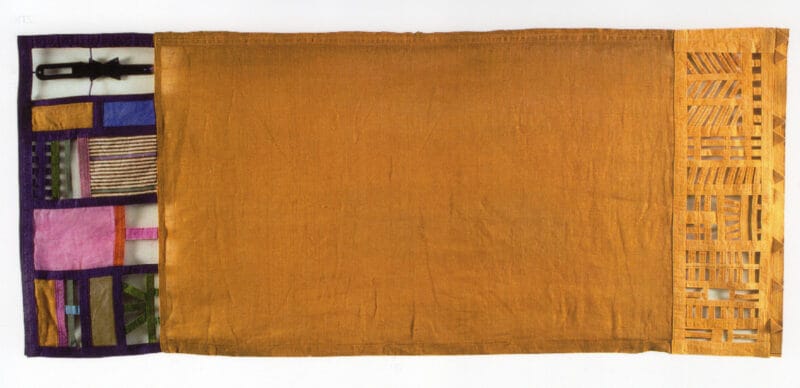MARIO TUDOR
[vc_row][vc_column][vc_row_inner][vc_column_inner width=”1/4″][vc_single_image image=”85701″ img_size=”full” alignment=”center” onclick=”custom_link” link=”https://www.artemorbida.com/prodotto/fiber-art-italiana-i-pionieri/?lang=en”][/vc_column_inner][vc_column_inner width=”3/4″][vc_column_text]
This column will present twice a month a historical figure of Italian Fiber Art, present in the book Fiber Art Italiana. I Pionieri.
You can buy it HERE[/vc_column_text][/vc_column_inner][/vc_row_inner][/vc_column][vc_column][vc_column_text]Mario Tudor was born in Gorizia in 1932, moved first to Venice, where he studied at the art high school and the first two years of the Faculty of Architecture, then to Trieste and in 1959 to Milan, where he was employed as an advertising graphic designer working for major brands.
In 1966 he left his job to devote himself exclusively to artistic activity, immediately reported by The New York Times and Herald Tribune International. In the mid-1970s by chance, replacing paper in an outdoor work that the rain had destroyed, he came across fabric, which from then on became the privileged support of his work.[/vc_column_text][vc_single_image image=”100218″ img_size=”full” add_caption=”yes” alignment=”center” onclick=”link_image”][vc_column_text]Mario Tudor’s artistic training took place in Venice, where he began oil painting with an abstract style of painting with precious chromatics. In 1974 he created a fragile outdoor installation for the gardens of the Palazzo Querini-Stampalia in Venice, The Kite on the Lawn, made with egrets, colored tissue paper and bamboo sticks that the rain destroys. The following year he replaces such perishable material with strips of cotton, sewn together and painted in vivid, transparent colors, with which he builds an outdoor path in Path No. 1: His journey in Fiber Art begins here.
The possibilities offered by fabric – its nonperishability, the irregular fringing of its edges, the grain of its surface, the possibilities of assemblage and overlapping – elect it as the material of choice. Tudor then learns to sew and to dye and paint fabric, to control each stage of creation and to exploit its full potential, whether intended or accidental. He invents a personal technique for manually coloring the fabric with broad, successive glazes of fabric dyes, achieving the depth typical of watercolor; he weaves the strips of canvas with a fretwork effect and punctuates them with black graphic interventions in the joint spaces, creating points of vital aggregation, of animated pulsation, which the artist calls: “the inhabitants of my works.”[/vc_column_text][vc_single_image image=”100224″ img_size=”full” add_caption=”yes” alignment=”center” onclick=”link_image”][vc_column_text]Between 1975 and 1979 he worked on the series of Wind Sculptures and Floating Sculptures, arranged above water in the canals of the lagoon, such as Ancha. At the same time he continued to create two-dimensional works with simple but unusual geometric forms, primary but singular.
This gave rise to the series named after the stars given to them by ancient Arab astronomers: Ksora and Kerb (both 1980), Kaape and Kai (both 1987), works with a scalar shape like astronomical maps, whose black background is studded with small pockets that when open show clear and bright shapes like animated galaxies; when closed, on the other hand, they “turn off” the sky, as in Borges’ story in which, after the prayerer has named all the names of God, the stars disappear and the world ends.
Other works that can be opened and closed include the Secret Notebooks series, which enclose mysterious colorful, throbbing objects in their inner pockets (such as calicantus seeds, the silhouette of a firefly, a small rubber lobster), and the Witches’ Pouches series, in the form of canvas bags strewn with pockets animated by tiny secrets.
Interested in bringing his works to life, he often makes it possible for the viewer’s intervention to modify the work, now by means of loops that allow the piece to be disassembled and reassembled at will, now by shifting the tension of the thread from which it hangs, obtaining ever-changing paths, now by opening and closing certain parts. The mysterious ideograms take on thickness and gain independence as primary biological units that live above and outside the fabric: first they are painted in black, then cut out in a brass plate, then in felt dyed and hardened by resins.[/vc_column_text][vc_single_image image=”100215″ img_size=”full” add_caption=”yes” alignment=”center” onclick=”link_image”][vc_column_text]In 1992 he created the series of Doors to the Wind, such as Blue Door and The Night Door, fixed at the top and constructed in the form of a pierced lintel, with the uprights raised and swaying with every shift of air caused by movement of those passing through them.
Another recurring theme is that of cloth tapestries structured according to the compositional mode of the oriental carpet, whose symmetry, however, it denies by thickening the patterns at the edges; as in: Campo giallo (1991) in a luminous mimosa yellow, Hortus conclusus (1994) and Campo di grano (2001) in its warm gradations that turn from turmeric yellow to terracotta. In Quarto nero (1996) two margins are fretwork effect crossed by light. While in The Day and the Night (2011) Tudor deploys sunny, daytime vitality on one margin and dark, nocturnal vitality on the other, around the central blue-violet. Untitled (2018) accentuates the lightness of the work. In its three-dimensional dimension that creates an enclosed space within which its ideograms are arranged behind and in front of the light cerulean lattice, animating it.
The Tower of Saved Signs (2012) is an editable work in which shifting panels reveal precious secrets and create ever new versions.
In his works, a taste for sensual and languid colors, lace-perforated surfaces, and Byzantine preciousness that he draws from his long residence in Venice, which Tudor tempers with the discretion and reserve that Milan imposes on its inhabitants, originate the unmistakable style, both sumptuous and measured, that characterizes his production.[/vc_column_text][vc_single_image image=”100221″ img_size=”full” add_caption=”yes” alignment=”center” onclick=”link_image”][/vc_column][/vc_row]
